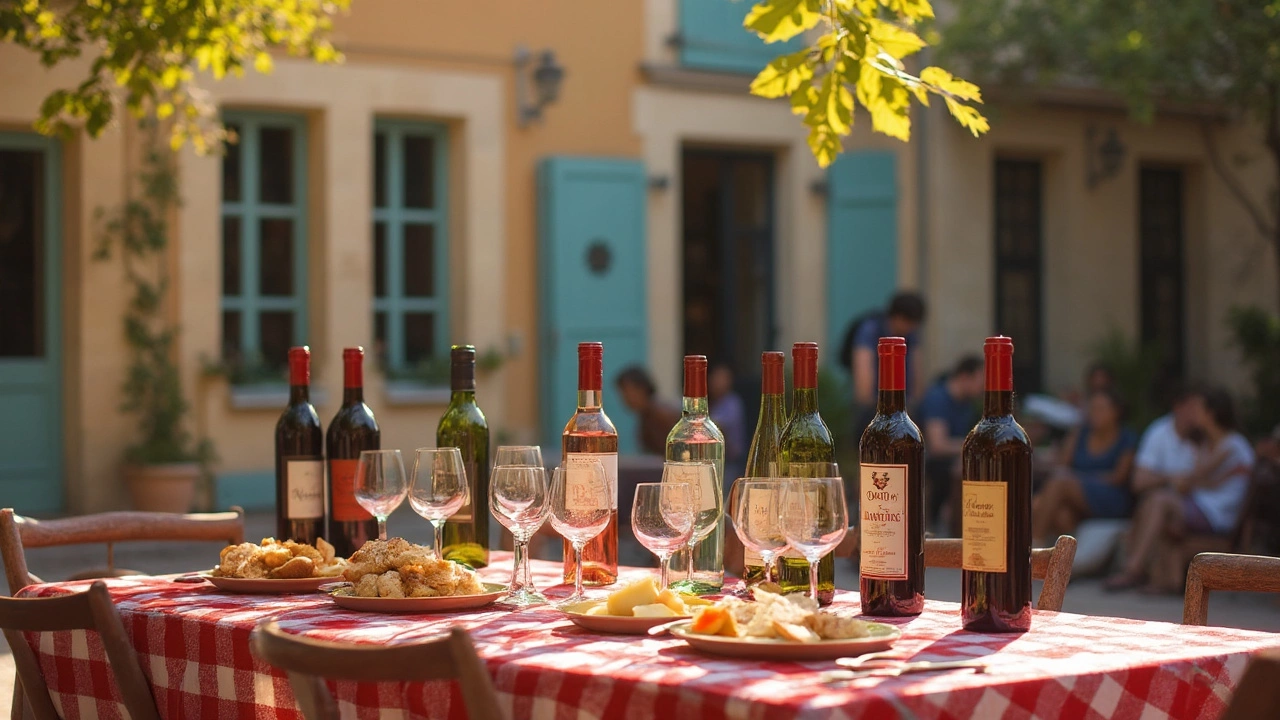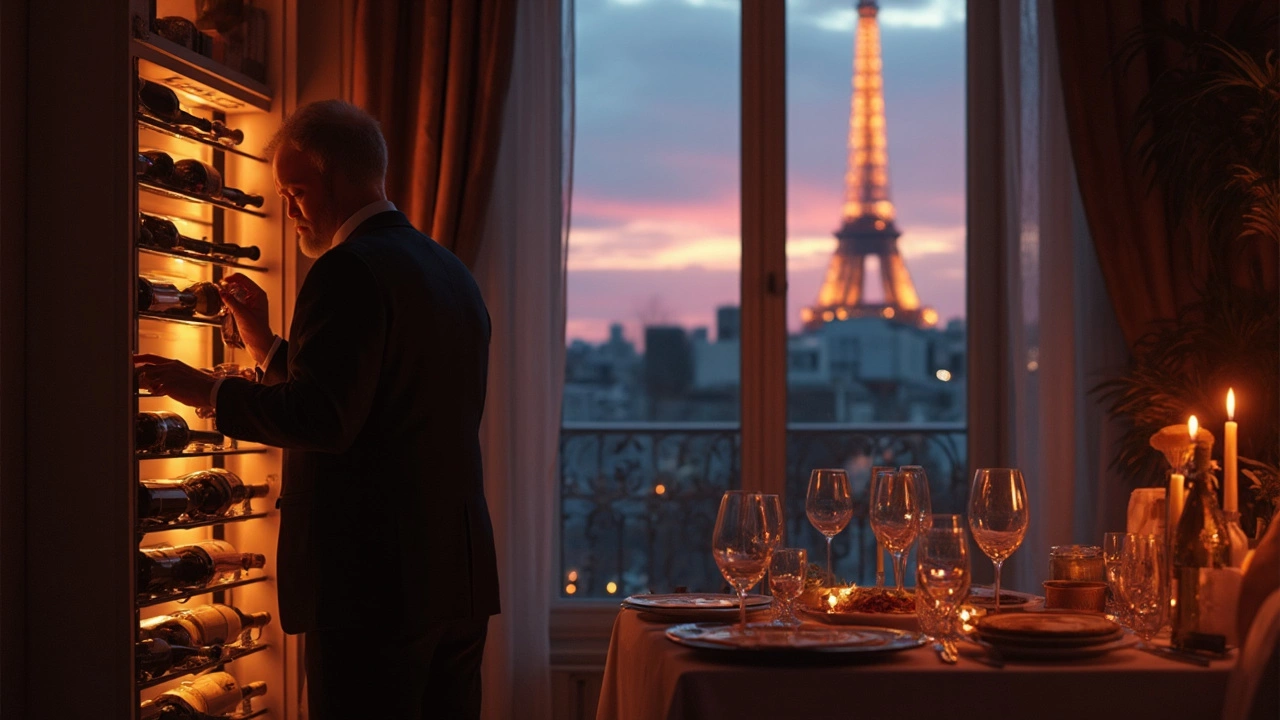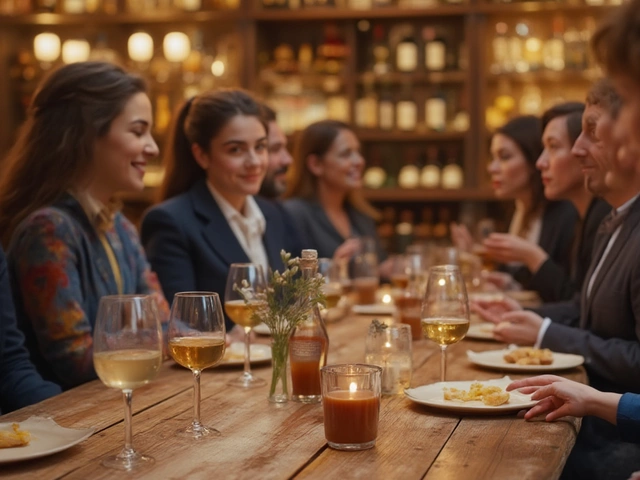Which Wine Is Best in France?
Think drinking wine in France is a simple affair? The truth is, the French treat wine like art. In Paris, couples lean in over candlelit tables, uncorking bottles worth more than most plane tickets home. Now, here’s the catch: the ‘best’ wine in France is less about finding a winner and more about enjoying the endless variety—from lush Bordeaux reds to crisp Loire whites. Some of the world’s most expensive bottles change hands in hushed auctions, while locals are happy with a €5 carafe that tastes of sun and soil. So, what makes one wine ‘best’ over another? It depends on your company, your meal, and sometimes, just your mood.
Understanding French Wine Classifications
French wine has rules—a lot of them. Every label you see carries a story about where the grapes grew and how the wine was made. The AOC—short for Appellation d'Origine Contrôlée—is the gold standard. Wines with AOC status stick to strict geographical and production rules. That’s why a Bordeaux really is a Bordeaux and a Chablis is never just another white wine.
Then there’s Vin de Pays. Translation? “Country wine.” These bottles allow winemakers more wiggle room—they can experiment, bend the rules, and use grape varieties not found in traditional AOCs. It’s where a lot of innovation happens (plus, prices are usually easier on your wallet).
At the entry level, look for Vin de France. These can blend grapes from anywhere in the country—sort of the French equivalent of “California Red.” Are they all bad? Not at all. Modern technology means you can still get quality, but you’re betting on the winemaker’s skills, not the laws or traditions.
This system keeps fakes at bay, too. Next time you’re looking at that price tag and wondering why one wine is ten times the cost of another, well, now you know: those letters—AOC, IGP, etc.—do the talking about quality before you take a single sip.
The Five Most Iconic Red Wines of France
Reds? France does them like no one else. From stately Bordeaux blends to the perfumed Pinot Noirs of Burgundy, each region’s red has its own character, mood, and loyal fans. Some people build their travel plans around châteaus and cellars known only to insiders, all for a single perfect glass. As varied as they come, French reds can change your mind about what wine is all about.
Bordeaux: The King of French Reds
Bordeaux reds are the real heavyweights. They’re made for aging, with a magical balance of deep black fruit, oak, and earthy notes. You’ll find the classic blend leaning on Cabernet Sauvignon and Merlot, occasionally with splashes of Cabernet Franc and Petit Verdot. The Left Bank wines have more structure and tannin; the Right Bank is softer and more Merlot-rich. Names like Château Margaux and Château Lafite Rothschild make collectors swoon—and not just because of price tags. The region produces more premium wine than anywhere else in France.
Pinot Noir from Burgundy
Burgundy stands in total contrast to Bordeaux. Here, Pinot Noir steals the spotlight. Light, aromatic, and surprisingly complex, a good Burgundy tastes like velvety cherries, earthy mushrooms, and soft spices—some fans call it “liquid silk.” Instead of powerful blends, you get single-varietal wines tied closely to their place. Burgundy’s tiny vineyards—often just a few acres—make it wildly expensive and difficult to get. Long-time fans say a top Burgundy, like those from Romanée-Conti, is as close as wine gets to magic. But don’t stress: you can find affordable Bourgogne Rouge in every Paris bistro.
Syrah from the Rhône Valley
Feeling adventurous? Rhône Valley Syrah delivers smoky, peppery, black-fruit flavors that feel like autumn in a bottle. In the north, the wines are robust and structured (think Hermitage or Côte-Rôtie). Down south, Grenache and Mourvèdre join the mix, making wines spicier and softer. Rhône Syrah is a favorite for cold evenings and hearty meals. It’s a red that always tastes like it has a story to tell—you just have to listen.
Merlot: The Smooth Operator
Let’s be real: Merlot is an easy-drinker—the kind of red you pour on first dates. France’s best come from Bordeaux, where Merlot blends are lush, soft, and full of plum and chocolate notes. You won’t battle with tannins or need to wait 10 years to enjoy these bottles. That’s why Merlot is a go-to for anyone just starting out, or for those who want something unfussy but delicious with roasted chicken or even a cheeseburger at a Parisian café.
Cabernet Sauvignon: Structured and Strong
You want structure? Reach for French Cabernet Sauvignon. This grape thrives in the Medoc and Graves districts of Bordeaux, offering black currant, cedar, and tobacco flavors, built for long aging. France is its home, but you’ll find Cab Sauvs everywhere now—the French taught the world how to do it right. A good French Cabernet won’t slap you in the face with jammy fruit. It’s more subtle, taut, and built for pairing with steak frites or a grilled lamb chop.
Top White Wines You Must Try in France
French whites can be sharp as a blade or soft as peach juice. You’ve never really had “white wine” until you’ve sipped a chilly glass on a summer terrace in France. Some are mineral-driven and crisp; others are full-bodied and every bit as complex as reds. If you know your way around Chardonnay and Sauvignon Blanc, you’re set. But push the boat out with lesser-known stars—France never fails to surprise.
Chardonnay: The Versatile Classic
Burgundy’s white Burgundies make wine geeks go weak in the knees. Chardonnay from this region—think Chablis or Meursault—can swing from steely and mineral (like licking wet stone) to buttery and rich, depending on the spot and the winemaker. The difference is all about terroir, that untranslatable word for the soul of the vineyard. Chablis, from the north, is as clean as a mountain stream. Meursault is creamy and nutty, just begging for a chunk of Brie. One grape, endless variations—a trademark of France.
Sauvignon Blanc from Loire
If summer had a flavor, it’d be Loire Valley Sauvignon Blanc. Sancerre and Pouilly-Fumé are crisp, grassy, and zingy—perfect with oysters or goat cheese. The zesty freshness pairs well with light meals, and the bottles don’t have the heaviness of oak-aged whites. Loire Sauvignon is the unofficial wine for Parisians at picnics along the Seine. Even if you just want something to take the edge off a sweltering afternoon, you can’t go wrong.
Riesling from Alsace
Riesling in Alsace is way drier than the famous German versions, packing bright citrus, floral, and mineral notes. It’s almost criminal how few people try it—among wine lovers, Alsace whites are cult favorites (and often bargains). These wines sing with spicy food and rich cheeses. Plus, Alsace’s patchwork of medieval villages and hills makes touring the local vineyards an adventure on its own.
What Is the Most Luxurious French Wine?
If money were no issue, where would your glass point? On collector wishlists, two names tower above all: Château Pétrus from Bordeaux and Romanée-Conti from Burgundy. Château Pétrus is pure Merlot and impossible to fake, with bottles routinely selling for over $3,000 apiece. It’s legendary for its richness and concentration—drinking it feels almost forbidden.
Romanée-Conti, the top wine from Domaine de la Romanée-Conti, is literally cultivated by hand. Some vintages fetch over $20,000. Why? The vineyard is tiny, just over a single hectare, and produces barely 6,000 bottles a year. Each sip is history in a glass. These labels aren’t about whether you “like” them—they’re status symbols, luxury experiences, and a bit of braggadocio rolled into a corked bottle.
Which Region in France Has the Best Wine?
Bordeaux has the prestige. Burgundy boasts the soul. Champagne wins hearts (and parties). Rhône Valley is the up-and-comer packed with value. If you put ten French wine lovers in a room and asked for their pick, you’d get eleven opinions. Bordeaux’s left and right banks each have devoted camps. Burgundy’s microscopic plots mean every wine is unique, driving collectors wild.
The Loire delivers crisp whites and light reds at friendly prices, while Alsace has food-ready wines for days. The secret is, each region’s “best” depends on what you love: Bordeaux for structure, Burgundy for finesse, Champagne for celebration, Rhône for spice. The French themselves drink local first—so ask around, follow your taste buds, and don’t be afraid to try unknown regions.
Pairing Wine with Romance: Why Paris Makes It Better
French wine makes good company even better, and nowhere does this play out more magically than Paris. It’s a city built for slow sips and stolen glances. The French take their time, turning an ordinary bottle and shared laughter into the main event. Wine isn’t just a drink; it’s a backdrop for romance, and it really does taste different when you’re looking over the city lights.
Where to Enjoy Wine and Intimacy in Paris
The best nights aren’t always found in five-star restaurants. Try a hidden rooftop bar, a candle-lit jazz club, or a cozy booth somewhere you can whisper without shouting. Find a wine cave near the Marais, or enjoy a nightcap with a paris escort by the lights of Pont Alexandre III. Those who know the city well prefer low-key wine bistros, holes-in-the-wall where the house wine is poured into unpretentious glasses.
How Parisians Combine Wine, Mood, and Meaningful Company
Parisians don’t rush. The wine, the meal, the company—they’re all woven together. It’s not about getting drunk; it’s about flirting with every sip and building an atmosphere that feels personal. You’ll see them savoring the aroma, letting the wine breathe, and taking just enough time so the night lingers. Whether it’s a quiet conversation or a shared secret, everything gets better with the right glass in hand.

Most Popular Wines Served in Paris Today
Walk into any Parisian bar or bistro and you’ll spot trends instantly. The go-to everyday red is usually a house Bordeaux or a young Côtes du Rhône—affordable, reliable, and easy to pair with charcuterie. Chablis and Sancerre reign among whites, a nod to their crisp flavors and their ability to cut through the city’s buttery sauces and fresh seafood. Pet-nat and natural wines are everywhere, appealing to the younger crowd with their cloudy looks and unpredictable flavors. If you’re visiting, trust the sommelier or just order whatever the locals are having—chances are, they know what’s good.
Choosing the Best Wine for Your First Trip to France
Visiting France for the first time? Don’t freeze up staring at wine lists longer than a novella. First, figure out if you want red, white, or sparkling. Reds like a Bordeaux blend are safe and satisfying. Whites from Loire—like Sancerre—or Burgundy Chardonnay are light, food-friendly, and easy to love. If you want bubbles, Champagne is everywhere (and not as expensive as you might fear, especially away from touristy bars).
- Order by the glass so you can try more without a big price tag.
- Ask for the house wine; it’s always good value.
- If a region’s name is on the label, chances are you’re getting something legit.
- Pair your wine with whatever the locals are eating—a little cheese, fresh bread, some oysters, or steak frites.
Be adventurous. Most French servers are used to tourists—just let them know your budget and what you like: fruity, dry, not too heavy, etc. They’ll set you up with something memorable.
French Wine Tasting Tips for Beginners
You don’t need to wear fancy clothes or memorize wine books to taste French wine like a local. Use your eyes first—watch how the wine clings to the glass. Give it a swirl, sniff it, and see what comes to mind. French wine is all about aroma: black cherries, tobacco, earthy notes in reds; citrus, floral, and minerals in whites.
- Sip slowly. Let it linger. The best wines have a “finish”—a taste that stays with you after you swallow.
- If it’s too rough, let it sit for a while. Some reds need a few minutes in the glass to open up.
- Don’t worry about “saying the right thing.” Wine is personal—just enjoy it.
If you’re feeling nerdy, here’s a quick tasting wheel:
| Step | What to Notice |
|---|---|
| Look | Color (light/dark, clear/cloudy), legs on glass |
| Smell | Fruit, earth, spices, flowers |
| Taste | Sweetness, acidity, tannin (for reds) |
| Finish | How long flavors last after swallowing |
This makes tasting wine fun—no pressure to sound like a snob. Wine is for pleasure, not performance.
Best French Wines for a Romantic Night In
If you’re picking a wine for an intimate night—whether it’s a new flame or your long-term love—go for balance. You want something soft, maybe a touch floral or fruity to set the mood. Reds like Pinot Noir or Merlot fit the bill. For whites, try a floral Viognier from Rhône or a slightly honeyed Chenin Blanc from the Loire.
Whites should be chilled but not ice-cold; reds shouldn’t feel hot when you touch the glass—room temperature is key. Pair your wine with simple snacks: a creamy Camembert, sliced fruit, or dark chocolate. A bonus tip? Stay away from heavy, tannic reds unless you know your date is a wine nerd—it can kill the mood (and wreck your palate for dessert).
Beyond the Bottle: The Culture Behind French Wine
French wine is a lifestyle. It’s how people mark holidays, seal deals, or just enjoy a Tuesday. Even school kids learn a bit about terroir and vintage before their first legal sip. Each region hosts festivals, vineyard tours, and endless tastings that tie communities together. Wine isn’t just a drink—it’s an identity, a way of making even simple moments feel special.
The culture also values who’s at the table; sharing a bottle is a social contract of sorts. People linger, talk, argue, make up—all over shared glasses. There’s sensuality to the ritual, a pace that feels old-world even in busy Paris. If you’re visiting, take your time. The best memories often start with a cork and end with new friends.
How to Buy Authentic French Wine Outside France
Outside France, finding the real deal means reading labels carefully. Look for the AOC (or sometimes AOP) symbol—this is your proof a wine was made and bottled in a designated French region. Reliable importers and established wine shops help steer you away from cheap imitations. Watch out for knock-off names or suspiciously low prices on famous regions.
- If the label says "Mis en bouteille au château/domaine," the wine was bottled at the estate—a good sign.
- Find a knowledgeable shop with staff willing to give recommendations. Avoid large grocery chains for special-occasion wines.
- If buying online, stick to reputable sites and check for customer reviews or ratings.
One tip for budget hunters: try lesser-known AOCs or IGP wines. They give you quality and save you cash. And don’t judge by price alone—you’ll be surprised how many $15 bottles from the Loire or Languedoc outshine their pricier cousins.

Conclusion: Let Taste and Context Decide the Best
No single bottle rises above all others as the absolute best French wine. That’s part of the country’s charm—every region, grape, and glass holds a new experience. The best wine is the one that fits your moment, your company, and your story. Want a heavyweight red? Go Bordeaux. Prefer something subtle and romantic? Try Burgundy. Looking to celebrate? Pop Champagne. The magic is in the match, not the price tag or the label. Don’t be afraid to explore—French wine rewards curiosity, not just tradition. Taste widely, pair boldly, and remember: in France, wine is about pleasure, never pressure.


